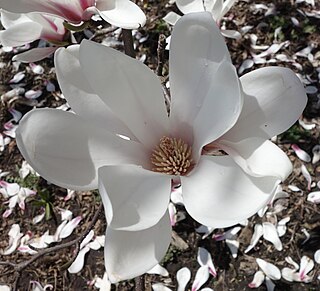
Magnolia is a large genus of about 210 flowering plant species in the subfamily Magnolioideae of the family Magnoliaceae. It is named after French botanist Pierre Magnol.

Magnolia acuminata, commonly called the cucumber tree, cucumber magnolia or blue magnolia, is one of the largest magnolias, and one of the cold-hardiest. It is a large forest tree of the Eastern United States and Southern Ontario in Canada. It is a tree that tends to occur singly as scattered specimens, rather than in groves.

Magnolia virginiana, most commonly known as sweetbay magnolia, or merely sweetbay, is a member of the magnolia family, Magnoliaceae. It was the first magnolia to be scientifically described under modern rules of botanical nomenclature, and is the type species of the genus Magnolia; as Magnolia is also the type genus of all flowering plants (magnoliophytes), this species in a sense typifies all flowering plants.

Magnolia tripetala, commonly called umbrella magnolia or simply umbrella-tree, is a deciduous tree native to the eastern United States in the Appalachian Mountains, the Ozarks, and the Ouachita Mountains. The name "umbrella tree" derives from the fact that the large leaves are clustered at the tips of the branches forming an umbrella-shaped structure.

Magnolia fraseri, commonly known as Fraser magnolia, mountain magnolia, earleaf cucumbertree, or mountain-oread, is a species of magnolia native to the south-eastern United States in the southern Appalachian Mountains and adjacent Atlantic and Gulf Coastal Plain from West Virginia south to northern Florida and west to eastern Texas. The Appalachian plants are classified as Magnolia fraseri var. fraseri, and the more coastal plants as M. fraseri var. pyramidata. These two kinds of magnolia are often recognized as distinct species, M. fraseri and M. pyramidata, respectively.

Magnolia macrophylla, the bigleaf magnolia, is a deciduous magnolia native to the southeastern United States and eastern Mexico. This species boasts the largest simple leaf and single flower of any native plant in North America.

Magnolia wilsonii, or Wilson's magnolia, is a species of Magnolia native to China, in the provinces of western Guizhou, Sichuan and northern Yunnan, where it grows in the forest understory at altitudes of 1,900-3,000 m, rarely up to 3,300 m.

Magnolia delavayi is a species of flowering plant in the genus Magnolia. It is known by the common names of Chinese evergreen magnolia or Delavay's magnolia. It was named after Father Delavay, French Catholic missionary in China, who collected it.

Magnolia officinalis is a species of Magnolia native to the mountains and valleys of China at altitudes of 300–1500 m.

Magnolia sargentiana is a species of flowering plant in the family Magnoliaceae. It is endemic to China, where it occurs in Sichuan and Yunnan. It is widely distributed but its populations are fragmented.

Magnolia champaca, known in English as champak, is a large evergreen tree in the family Magnoliaceae. It was previously classified as Michelia champaca. It is known for its fragrant flowers, and its timber used in woodworking.

Magnolia cylindrica, the Huangshan magnolia, is a species of plant in the family Magnoliaceae. It is endemic to China. It is threatened by habitat loss.
Magnolia kachirachirai is a species of flowering plant in the family Magnoliaceae. It is endemic to Taiwan.

Magnolia rostrata, the beaked magnolia, is a species of plant in the family Magnoliaceae. It is found in the Himalayas. It is an IUCN Red List endangered species, threatened by habitat loss.

Magnolia zenii is a species of plant in the family Magnoliaceae. It is endemic to China.
Magnolia dandyi is a species of plant in the family Magnoliaceae. It is native to north Vietnam, Laos and China where it occurs in the Yunnan and Guangxi provinces. It is threatened by habitat loss.
Manglietia ovoidea is a species of flowering plant in the family Magnoliaceae. It is endemic to China. There are only four small subpopulations of this critically endangered species.
Ostrya rehderiana is a tree in the Betulaceae family. It can grow up to 15 metres (49 ft) tall. It is endemic to Zhejiang province in China. The wild population apparently consists of only five trees on Tianmu Mountain, and the species is under first-class national protection in China.

Changnienia is a genus of flowering plants from the orchid family, Orchidaceae. Only one species is known, Changnienia amoena, native to China.

Magnolia liliifera, commonly known as egg magnolia, is a flowering tree native to the Indomalayan realm. It bears white to cream-colored flowers on terminal stems. The leaves are elliptical and get as large as 10 inches long and 3 inches wide. The tree ranges in height of 12–60 feet in situ.




















